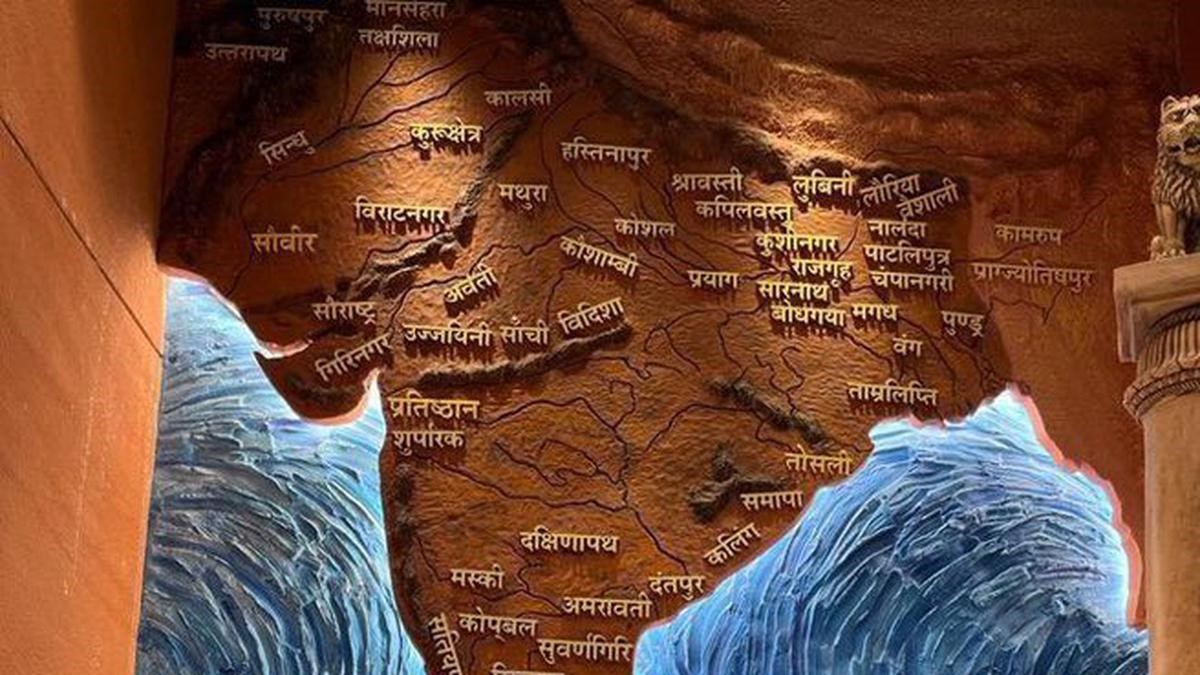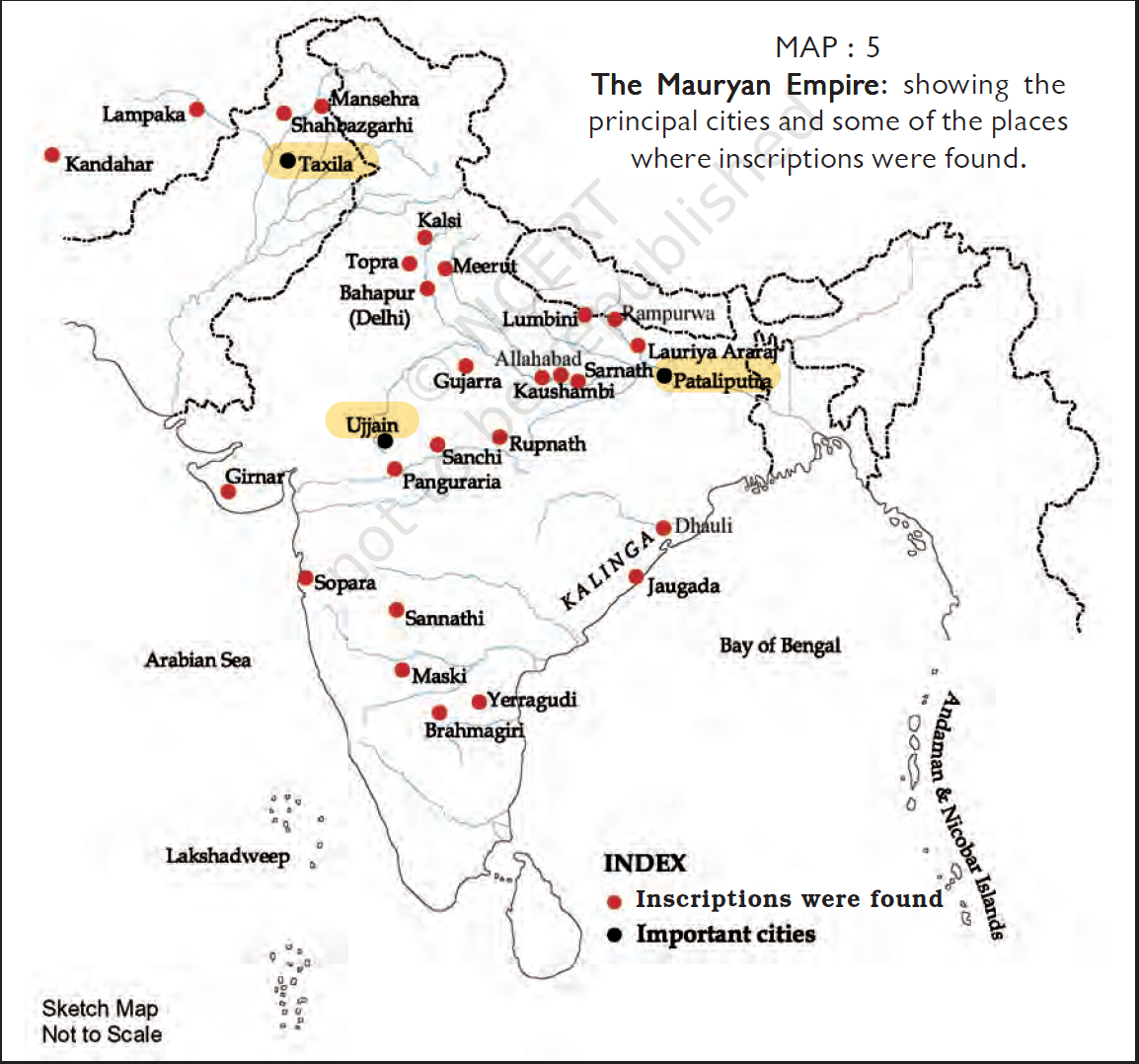Description

Disclaimer: Copyright infringement not intended.
Context
- Ministry of External Affairs clarified on the Controversy which has emerged over the mural of the Indian sub-continental landmass in the art gallery of newly inaugurated Parliament building
This Akhand Bharat Mural has triggered some controversy and some concern in the neighbouring countries of Pakistan and Nepal
Concerns over Ashokan Mural
- This Mural in the new Parliament building is being interpreted as a map of Akhand Bharat'.
- It marks important kingdoms and cities of the past, and shows the influence of ancient India in the then Taxila, in present-day Pakistan.
- Pakistan’s Foreign Ministry spokesperson expressed its concern that this Mural suppress the ideology and culture of religious minorities of neighbouring country
- There are few reports of street level protest led by opposition in Nepal over the inclusion of some parts of Nepal, for instance Lumbini (birth place of Gautam Buddha), in the Mural.
- Though the issue is not raised formally by Nepal through official channels, former Prime minister of Nepal Baburam Bhattarai is of opinion that the mural may cause unnecessary diplomatic disputes. He also opined that it may widen the trust deficit between Nepal and India.

Response from Ministry of External Affairs
- Arindam bagchi, External Affairs Ministry spokesperson, has clarified that there is no need to be concerned regarding the mural in question.
- This Mural as an artwork depicts the spread of prehistoric Ashokan Empire and hence it promotes and propagates the idea of responsible and responsive government in line with the Ashokan administration.
Ashokan Empire
- Ashoka, literally means without sorrow, was the third Mauryan king who is believed to be ruled during 272/268 – 231/232 BCE.
- He is also referred as Devanampiya Piyadassi (Beloved of the Gods).
- The Mauryan empire that Ashoka ruled was founded by his grandfather, Chandragupta Maurya, more than 2300 years ago.
- He was one of the greatest rulers of world and the first ruler to take his message/Instructions to the people through inscriptions (Mostly in Prakrit, written in Brahmi scrip) which were inscribed on pillars, as well as on rock surfaces.
- The inscriptions of Ashoka were found from the present-day North West Frontier Provinces of Pakistan, to Andhra Pradesh, Orissa and Uttarakhand in India. It suggests the expansion of Mauryan empire under Ashoka.
- He won Kalinga, ancient name of coastal Orissa, war around 260 BCE but horrified by the mass killing, bloodshed and violence. Hence he decided to gave up the violence and decided to observe dhamma to win people .
Ashoka’s dhamma
- It did not include worship of a god, or performance of a sacrifice.
- It involves respect towards elders, generosity towards Brahmanas and those who renounced worldly life, treating slaves and servants kindly, and respect for religions and traditions other than one’s own.
- He considered a duty to instruct his subjects about teachings of the Buddha.

Disclaimer: Copyright infringement not intended.
Unique Features of Ashoka Empire and administration
- Mauryan administration was highly centralized where Emperor, assisted by ministers, was the supreme power and source of all authority. Control of king was strongest in areas around the capital and the provincial centres
- The five major political centres in the empire were – the capital Pataliputra and the provincial centres of Taxila, Ujjayini, Tosali and Suvarnagiri. However For better administration, Kingdom was divided in various subordinate units
- These centres were carefully chosen, both Taxila and Ujjayini were situated on important long-distance trade routes, while Suvarnagiri (literally, the golden mountain) most likely has significance for tapping the gold mines of Karnataka.
- To be more precise, Taxila was a gateway to the northwest, including Central Asia, while Ujjain lay on the route from north to south India.
- For implementation of policies and laws there were various officials and authorities which includes for instance the Mahamantri (Prime Minister), the Senapati (general), Amatyas (civils servants) etc.
- The administration was driven by a welfare and people centric approach which included construction of roads, digging wells, and building rest houses.
- He promoted the mutual respect of religions and teachings of Buddha thus preaching the values of tolerance and non-violence in society.
- He also arranged for medical treatment not just for human beings but for animals too.
- There was regular tax collection and conduction of regular census.
- He tried to unify empire through dhamma and appointed officials known as dhamma mahamatta to spread ideas about dhamma to other countries, such as Syria, Egypt, Greece and Sri Lanka.
Other notable points
- Around 247 BCE the 3rd Buddhist council was convened at Asokarama in Pataliputra, under the patronage of Emperor Ashoka.
- State Emblem of India is adopted from Lion Capital of Ashoka from Sarnath.
- This Lion Capital of Ashok also serves as the source of "Ashoka Chakra" which is placed on centre of the flag of India (Tiranga).
|
PRACTICE QUESTION
Q) Emperor Ashoka is considered to be one of the greatest kings in the recorded history of India. Discuss with reference to the Ashoka’s administration and policy of dhamma. (150 words)
|

https://epaper.thehindu.com/ccidist-ws/th/th_delhi/issues/37892/OPS/G67B9UK5D.1+GA3B9VI3D.1.html








